



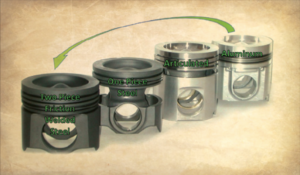 In some ways, history has repeated itself in heavy-duty diesel piston design. The industry has seen the older cast aluminum pistons replaced by articulated (steel crown and aluminum skirt). The articulated then evolved into the one-piece steel, and more recently into the friction-welded steel pistons that have the basic structure of the original aluminum piston. Cylinder temperatures, pressure, horsepower, and cleaner emissions were more than the aluminum alloys could contend with. Steel pistons are more robust and can withstand the rigorous demands required of the later model engines. Steel pistons also have much tighter tolerances and with less thermal expansion, allow for tighter clearances than aluminum pistons.
In some ways, history has repeated itself in heavy-duty diesel piston design. The industry has seen the older cast aluminum pistons replaced by articulated (steel crown and aluminum skirt). The articulated then evolved into the one-piece steel, and more recently into the friction-welded steel pistons that have the basic structure of the original aluminum piston. Cylinder temperatures, pressure, horsepower, and cleaner emissions were more than the aluminum alloys could contend with. Steel pistons are more robust and can withstand the rigorous demands required of the later model engines. Steel pistons also have much tighter tolerances and with less thermal expansion, allow for tighter clearances than aluminum pistons.

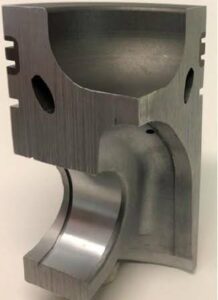
The aluminum pistons have had their share of manufacturing challenges. From heat plugs that limit erosion, single or dual Ni-Inserts are cast into the crown to improve ring lands and internal oil galleries to cool the piston crown.
So, how do you take the advancements of the previous designs and make them into a steel piston? That is the wizardry behind making steel pistons for heavy-duty diesel engines.
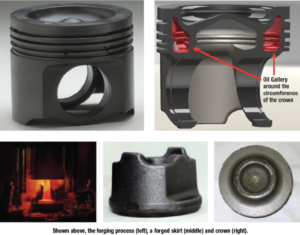
And just to keep the contest fair, the magical abilities need to include an internal oil gallery inside the steel piston crown. The coatings on steel pistons mask a glitchy appearance, and when you look at the detail that goes into manufacturing them, you realize they are a work of art.
To start with, the forging dies need to be developed. Not overly impressive to look at, but if the forgings are too big it adds to machining time and wastes material. If the forgings are too small, well then you

From there the machining processes start and the raw forgings and billets are rough turned. The piston skirts and crowns start to take shape.
The rough-turned crowns and skirts are matched together. And again, this is where the magic comes into play.

The skirt and crown are inserted into the fixtures of the inertia welding machine.
With the crown rotating and the skirt held firmly in place, the crown is then forced against the skirt creating the inertia weld. Machined tolerances of the skirt and crown, speed of rotation and applied force are all critical components for a successful weld.
Series of photos show the skirt and crown in the inertia welding machine
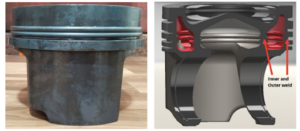
Just to complicate this a little further, this is two welding processes at the same time. If these components and the welding process are not correct, the piston will fail the next quality inspection and you have created another expensive piece of scrap metal.

The rough piston is then fixtured, and the finished machining processes begin. Through a series of rotating machine heads and cutting tools the outside diameter, ring lands (grooves) and piston crown are all completed in a matter of minutes.
The next inspection process digitally checks the skirt diameter, ring land diameters and root depth of the ring grooves, the crown height and profile. Electronic gauges assure accuracy and consistency to each specification. There is no “guess” work here, the piston either passes all parameters or it fails. The manufacturing process must be able to produce consistent results, or the process is flawed and useless.
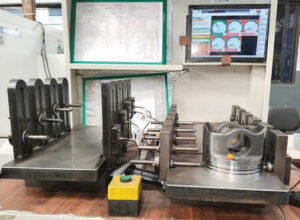
Having passed each of the inspection stages the piston is now nearing the final machining phases. The retainer (circlip) grooves are machined and verified.
The last step in the machining process, and arguably the most important, is the pin bore. What appears to be a straight bore through the piston for the piston pin is instead a very detailed and precise profile.
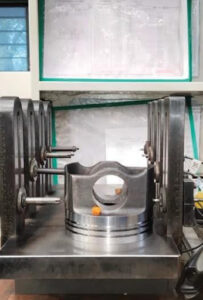
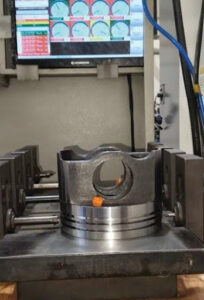
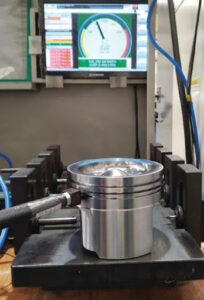


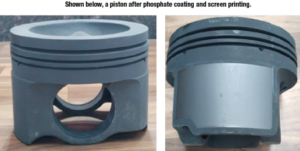
Once the pin bore profile has been checked the piston is ready for deburring.
Finished yet? Not even close, now onto more inspections, cleaning, phosphate coating, screen printing, laser marking, demagnification, and oiling. Manufacturing a piston is not for the impatient.
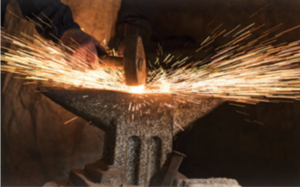
It will be interesting to see what method and materials come out of the wizard’s fiery furnace the next time the doors open.
Steve Scott joined the service department at lPD in 1982, working with parts, service and sales for a variety of equipment, diesel, and natural gas engines. Since 2004, he has been the director of product development and technical support for lPD. For more information, email sscott@ipdparts.com.
If you’re an existing customer and already have a login, click here to find IPD quality parts.
If you would like to find an IPD distributor or become an IPD distributor, please fill out our form.